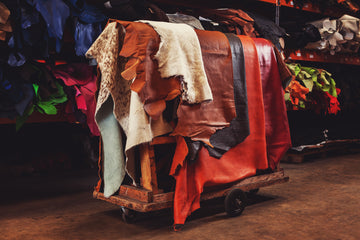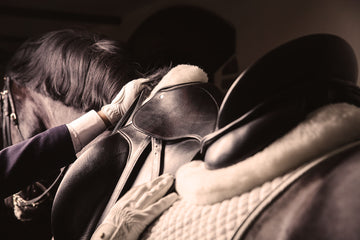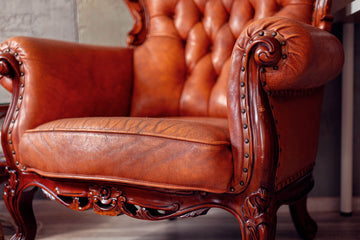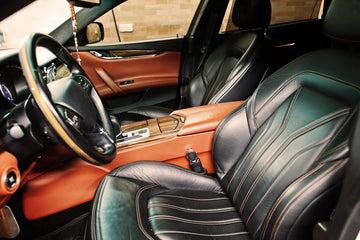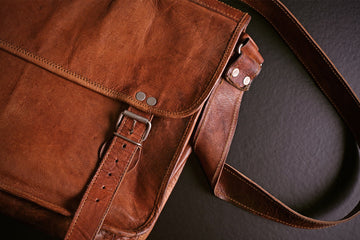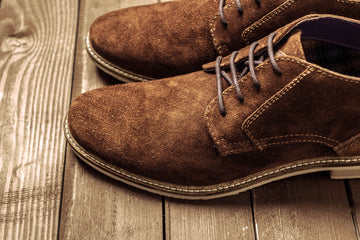To find the ideal leather for saddles, it's essential to weigh considerations like how much durability is required, your comfort level preference, and readiness to undertake maintenance. This exploration breaks down the advantages and disadvantages of full-grain, top-grain, and synthetic leather varieties of prevalent saddle leathers. Grasping these distinctions is crucial whether you're a rider who competes or one who rides leisurely so that you can select the most suitable material for your saddle.
Key Takeaways
- Full-grain leather is the highest quality leather for saddles due to its durability, comfort, and unique appearance, although it requires more maintenance than other types.
- Top-grain and synthetic leathers offer more uniformity and are less expensive, with synthetic being an ethical, lightweight option; however, both have lower durability than full-grain leather.
- The tanning process significantly impacts the leather's quality, with vegetable tanned being eco-friendly and durable, chrome tanned being quick to produce but environmentally harmful, and synthetic tanned less impactful on the environment.
Exploring Leather Types for Horse Saddles
When it comes to horse saddles, the choice of leather is paramount. Not only does it affect the durability and comfort of the saddle, but it also influences the rider's control and the horse's well-being. With various leather types available, selecting the ideal one for horse saddles requires understanding the characteristics of each leather type, including strength, finish, durability, and grain type.
Within saddle creation, it's evident that not all leathers share the same quality. The selection of leather for a saddle influences several aspects, including:
- Its aesthetic appeal and suitability for competitive events.
- Necessary upkeep.
- Longevity.
- Provided comfort.
Our discussion will focus on three primary types of leather commonly employed in making saddles: full-grain leather, full-grain or top-grain leather, and synthetic varieties.
Full-Grain Leather
Full-grain leather is frequently the show's star for superior horse saddles. Renowned for its durability and resilience against wear and tear, this most natural and durable type of leather maintains its strength while exhibiting unique grain patterns and marks on its unaltered surface that give every saddle a one-of-a-kind look.
Due to the preserved integrity of full-grain leather, it gradually conforms to a rider's shape with time. This personalised fit increases ride comfort and solidifies genuine full-grain leather as an outstanding material for those prioritising lasting ride quality and riding ease.
- Strength and Durability: Highly resistant to wear and tear, perfect for frequently used saddles.
- Finish: Natural look with minimal treatment, allowing the leather to age gracefully.
- Maintenance: Requires regular conditioning to maintain its flexibility and prevent drying out.
Top-Grain Leather
Top-grain leather is an excellent choice for prioritising a consistent look and simple upkeep. Saddle enthusiasts appreciate the durability, attractive design, and affordability of top-grain leather saddles compared to the full-grain leather alternatives—qualities that make them economically appealing for occasional riders. The careful craftsmanship inherent in English and European production methods places these particular top-grain leathers in high regard among saddle connoisseurs.
While they may not reach the unparalleled longevity of full-grain leather knee pads, their economic benefits and minimal care demands make them particularly popular with riders who opt for knee pads to enhance safety.
- Strength: Slightly less durable than full-grain but still robust for regular use.
- Finish: More consistent appearance and available in various colours and finishes.
- Maintenance: Easier to clean and maintain due to its processed surface.
Split Leather
Split leather, derived from the lower layers of the hide, is more affordable but less durable than full-grain or top-grain leather. It's often used with other materials to make suede or as the backing material for laminated leathers. Split-grain leather saddles are softer and more flexible but lack the strength and durability needed for heavy use. Characteristics of split leather include:
- Strength: Suitable for light use but not recommended for rigorous activities.
- Finish: Has a napped surface if turned into suede, offering a unique texture.
- Durability: Less resistant to water and wear, requiring more careful maintenance.
Bridle Leather
Bridle leather is treated explicitly for use in equestrian equipment, including saddles. It undergoes a rigorous tanning process, making it extremely tough and durable while still being flexible. Bridle leather is designed to withstand the elements, making it suitable for outdoor use. Its main characteristics are:
- Strength: Excellent strength and durability, able to withstand harsh conditions.
- Finish: Smooth and polished, often darkening beautifully over time.
- Maintenance: Needs regular oiling to maintain its condition and prevent cracking.
The Tanning Process and Its Impact on Saddles
To appreciate the various types of leather utilised in horse saddles, it's crucial to grasp the tanning process. This critical step significantly impacts the durability, colour, smell, and overall leather quality designed for saddle making.
Tanning Methods
Leather is tanned using three principal tanning techniques: vegetable, chrome, and synthetic. The vegetable method utilises organic materials such as tree bark to create a product that is not only durable but also environmentally friendly since it involves natural agents for the skin tanning process that do not emit dangerous gases.
The second method commonly employs chemicals like chromium sulfate for chrome-tanning leather. While this approach allows faster and more cost-effective leather production, it raises environmental concerns due to water contamination and non-biodegradable nature.
Lastly, leather hides can be tanned using synthetic methods which involve artificial compounds like acrylic resins. This technique offers benefits in terms of mass production by diminishing environmental harm through reduced water pollution and the elimination of noxious chemical use. It results in an artificial grain imparted onto the animal skin material's surface.
Bridle Leather
Leather specifically designed for bridles undergoes a specialised treatment process that reinforces its durability and resistance, making it an exemplary material for crafting equestrian gear. This supple leather is frequently sourced from top-quality Italian aniline-dyed hides, positioning bridle leather as a premium option over other dyed leathers.
The particular processing approach commonly taken with bridle leather makes it exceptionally fit for producing saddles and diverse horse riding equipment materials and apparatus, granting them the strength to withstand the rigorous environments typically faced throughout horseback riding activities.
Environmental Factors
When choosing the type of leather for a saddle, it is crucial to consider the environmental conditions in which it will be employed. The durability and effectiveness of the saddle can be significantly impacted by heat, moisture, and wear.
In areas with elevated humidity levels or drastic surface temperature fluctuations, opting for a genuine leather or variant that demonstrates exceptional resistance to such extreme conditions might be necessary.
The Best Leathers for Horse Saddles
Aside from the main varieties, horse saddles can also be crafted from speciality leathers such as buffalo, harness, and calfskin. These kinds of leather may be less frequently utilised than the primary ones, but they provide distinctive characteristics and visual appeal to a saddle. These types of leather have the potential to improve certain performance qualities of the saddle.
Buffalo Leather
Derived from buffalo hide, buffalo hide or leather is lauded for its exceptional strength and distinctive texture. This makes it a material ideally suited to meet the rigorous requirements of horse riding. Riders frequently experience immediate comfort when using products made with buffalo hide or leather, which often feels 'broken in' right off the bat. This feature spares them an extended break-in duration for riding equipment.
Not only does the weight, thickness and unique texture of buffalo leather add to its aesthetic appeal, but it also improves grip and stability for riders during their equine endeavours.
Harness Leather
Harness leather is a robust leather enriched with additional oil and wax after the standard tanning process. This extra treatment improves its smoothness, grip and endurance, making the skin on it more pliable initially while ensuring that it possesses a heavier density for each unit of thickness and weight.
Initially crafted to meet the rigorous needs of horse harnesses, the attributes of harness leather make it an adaptable material ideal for producing parts of saddles where resilience and adaptability are crucial.
Calfskin
Calfskin leather, celebrated for its supreme softness and soft, opulent texture, is frequently selected for use in premium horse saddles. With an average thickness of approximately 4.3 mm, this material perfectly balances its natural pliability and the essential robustness riders commonly require. The delicate grain and soft and sleek exterior enhance the visual appeal of top-tier saddle-making.
As such, these distinctive qualities render calfskin an optimal selection for crafting luxury saddles that cater to high-end markets.
Maintenance and Care of Leather Saddles
Maintaining your saddle's performance and durability is crucial, necessitating consistent care. How often maintenance needs to occur hinges on the type of leather used, as certain leathers may require more regular attention.
Cleaning and Conditioning
Maintaining the durability and condition of a saddle necessitates consistent cleaning and conditioning. This maintenance involves meticulous removal of grime using sanded, soft dust cloth, employing soap to scrub in gentle circular strokes, and diligently eliminating any remaining residue with particular attention to nooks.
It is essential to use appropriate conditioners tailored for various leather types.
Adopting measures such as refraining from resting wet saddle pads on the leather post-use can prevent harm caused by built-up perspiration, thereby prolonging the serviceable life of your ride and saddle.
Repair and Restoration
Over time, saddles may show signs of wear and tear or damage that could require repair or replacement. The steps involved in the repair and restoration process include:
- Meticulous inspection to identify problems.
- Extensive cleaning.
- Leather conditioning.
- Application of specialised methods suited for the specific type of leather.
In considering whether to restore a saddle, it is essential to weigh the costs against the benefits because there might be instances where replacing a saddle is more cost-effective than attempting repairs.
Top-grain leathers of inferior quality, which use dyes that are not resistant to fading and have less durability against wear and tear, can present issues such as cracking and splitting. These difficulties can make repairing and restoring these types of leathers more challenging.
Factors to Consider When Choosing Leather for Saddles
Choosing the ideal leather for a saddle involves careful consideration, influenced by the rider's taste, purpose, and commitment to consistent upkeep and care.
The necessity of high-quality leather cannot be overstated when crafting a saddle that offers outstanding strength and durability, ensuring endurance through the demands of riding and offering both horse and rider comfort and adaptability. The long-term benefits of choosing quality leather for saddles are clear in terms of their lasting performance, though they require ongoing attention to maintenance.
Leather should offer a certain degree of flexibility to conform to the horse's back and provide comfort for both the horse and rider. It should not be too stiff, which can cause discomfort or injury. The appearance of the saddle and hide is also essential, especially for show saddles. The leather should have a quality finish that complements the riding style and meets the rider's aesthetic preferences.
High-quality leather can be expensive, but investing in good material pays off in the long run through the saddle's longevity and performance. Balance your budget with the quality of leather to find the best option for your needs. Choosing the right leather for saddle-making is about finding the best combination of these factors to suit your specific riding discipline, personal preferences, maintenance capacity, and budget.
Summary
In conclusion, the choice of leather for a saddle is a paramount decision that affects the saddle's durability, comfort, and the rider's control. Each leather type offers unique properties, from full-grain leather's natural look and adaptability and top-grain leather's uniform appearance and ease of maintenance to synthetic leather's affordability and ethical considerations. Tanning process and methods, environmental factors, maintenance, and care practices further influence the saddle's quality and longevity.
Speciality leathers like buffalo, harnesses, and calfskin provide unique properties and aesthetics. However, the ultimate decision depends on the rider's preference, intended use, and regular maintenance and care commitment.
Explore our vast selection of premium leather hides, specially curated for crafting horse saddles, available in various colours and finishes to match your specific needs. Our high-grade leathers are available for online purchase, ensuring a hassle-free shopping experience with swift delivery to your doorstep anywhere across the globe.
🔗 Browse our leather collection
If you have any questions about the various types and qualities of leather suitable for making saddles, please do not hesitate to contact us. We aim to provide you with a thorough understanding of each type of leather so you can make the best choice for your saddle. This will help to improve its appearance, texture, and durability.
